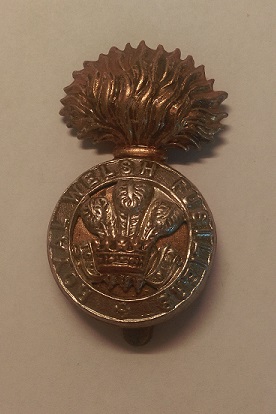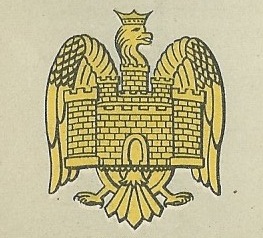Related Research Articles

The Royal Welch Fusiliers (Welsh: Ffiwsilwyr Brenhinol Cymreig) was a line infantry regiment of the British Army, and part of the Prince of Wales' Division, that was founded in 1689; shortly after the Glorious Revolution. In 1702, it was designated a fusilier regiment and became the Welch Regiment of Fusiliers; the prefix "Royal" was added in 1713, then confirmed in 1714 when George I named it the Prince of Wales's Own Royal Regiment of Welsh Fusiliers. In 1751, after reforms that standardised the naming and numbering of regiments, it became the 23rd Regiment of Foot (Royal Welsh Fuzileers). In 1881, the final title of the regiment was adopted.

The Lancashire Fusiliers was a line infantry regiment of the British Army that saw distinguished service through many years and wars, including the Second Boer War, the First and Second World Wars, and had many different titles throughout its 280 years of existence. In 1968 the regiment was amalgamated with the other regiments of the Fusilier Brigade – the Royal Northumberland Fusiliers, Royal Warwickshire Fusiliers and the Royal Fusiliers – to form the current Royal Regiment of Fusiliers.

The Welch Regiment was an infantry regiment of the line of the British Army in existence from 1881 until 1969. The regiment was created in 1881 under the Childers Reforms by the amalgamation of the 41st (Welch) Regiment of Foot and 69th Regiment of Foot to form the Welsh Regiment, by which it was known until 1920 when it was renamed the Welch Regiment. In 1969 the regiment was amalgamated with the South Wales Borderers to form the Royal Regiment of Wales.

The York and Lancaster Regiment was a line infantry regiment of the British Army that existed from 1881 until 1968. The regiment was created in the Childers Reforms of 1881 by the amalgamation of the 65th Regiment of Foot and the 84th Regiment of Foot. The regiment saw service in many small conflicts and both World War I and World War II until 1968, when the regiment chose to be disbanded rather than amalgamated with another regiment, one of only two infantry regiments in the British Army to do so, with the other being the Cameronians.

The King's Shropshire Light Infantry (KSLI) was a light infantry regiment of the British Army, formed in the Childers Reforms of 1881, but with antecedents dating back to 1755. It served in the Second Boer War, World War I and World War II. In 1968, the four regiments of the Light Infantry Brigade amalgamated to form The Light Infantry, with the 1st KSLI being redesignated as the 3rd Battalion of the new regiment.
The Isle of Man Volunteers was a nominal battalion of Britain's Volunteer Force formed during the 1860s and disbanded in 1920. Its service companies saw active service in the Second Boer War and World War I. During its existence, the battalion had the distinction of being the only representative of the Isle of Man in the British Army, and the last Volunteer Force unit.

The Bedfordshire Yeomanry was a Yeomanry regiment of the British Army. Serving intermittently between 1797 and 1827, it was re-raised in 1901 for the Second Boer War. It participated in the First World War before being converted to an artillery regiment. It served in the Second World War. Its lineage was maintained by 201 Battery, 100th (Yeomanry) Regiment Royal Artillery until that unit was placed in suspended animation in 2014.
The 28th Division was an infantry division of the British Army raised for service in World War I.
The 158th Infantry Brigade was an infantry brigade of the British Army that served in both the First and Second World Wars, before being disbanded in 1968. Throughout its existence the brigade was assigned to the 53rd (Welsh) Infantry Division and was composed almost entirely of Territorial battalions from the Royal Welch Fusiliers.
The Liverpool Brigade, later 165th (Liverpool) Brigade was an infantry brigade of Britain's Volunteer Force that served during World War I with the 55th Division of the British Army. During World War II, again as part of the 55th Infantry Division, the brigade remained in the United Kingdom.
The 83rd Brigade was an infantry brigade formation of the British Army. It was originally formed from regular army battalions serving away from home in the British Empire. It was assigned to the 28th Division and served on the Western Front and the Macedonian Front during World War I. The Brigade was temporarily attached to the 5th Division between March and April 1915.
The 85th Brigade was a formation of the British Army. It was originally formed from regular army battalions serving away from home in the British Empire. It was assigned to the 28th Division and served on the Western Front and the Macedonian Front during the First World War. The Brigade was temporarily attached to the 3rd Division between February and April 1915.
The 169th Brigade was an infantry brigade of the British Army that saw active service in both the First and the Second World Wars. Throughout its existence the brigade, serving under numerous many different titles and designations, was an integral part of the 56th (London) Infantry Division. It served on the Western Front in the First World War, and in the North African and Italian campaigns during the Second World War.
The 113th Brigade was an infantry brigade formation of the British Army active in both the First and the Second World Wars.

The British yeomanry during the First World War were part of the British Army reserve Territorial Force. Initially, in 1914, there were fifty-seven regiments and fourteen mounted brigades. Soon after the declaration of war, second and third line regiments were formed. However, the third line regiments were soon absorbed into the Cavalry Reserve Regiments, to supply replacements for the cavalry and yeomanry. Other horsed regiments in the British Army, during the war, were the regular cavalry regiments and the three regiments belonging to the special reserve: the North Irish Horse, the South Irish Horse and the King Edward's Horse. The senior yeomanry regiments could trace their origins back over 100 years; the oldest regiment, the Royal Wiltshire Yeomanry, had been formed in 1794. The most junior regiment, the Welsh Horse, had only been formed on 18 August 1914, after the start of the war.

The Monmouthshire Regiment was a Territorial infantry regiment of the British Army. Originating in units of rifle volunteers formed in Monmouthshire in 1859, the regiment served in the Second Anglo-Boer War and both World War I and World War II before losing its separate identity in 1967.
242nd Brigade was an infantry formation composed of British and Indian troops, which served in Turkey during the Occupation of Constantinople after World War I
The South Wales Brigade was a Territorial Force infantry brigade of the British Army. Formed in 1908, it was not part of any division, instead serving as Army Troops, though attached to the Welsh Division in peacetime. It was dissolved in early 1915 as its constituent battalions were posted to other formations.
References
- ↑ "28th Division". The Long Long Trail. Retrieved 20 January 2012.
- ↑ Becke, Major A. F. (1935). Order of Battle of Divisions Part 1. The Regular British Divisions. London: HMSO. p. 106. ISBN 1-871167-09-4.